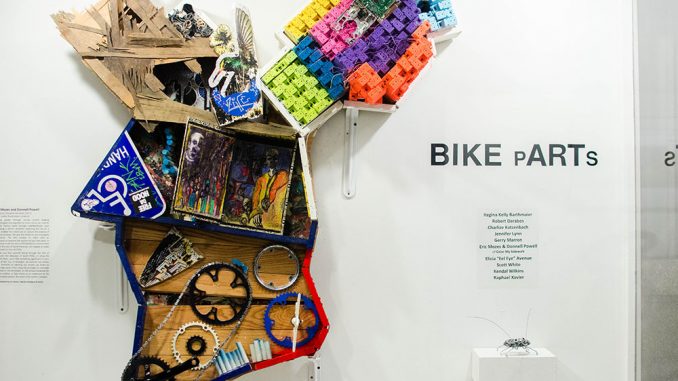
Donnell Powell and Eric Mozes did not major in art while at Temple, but before the last semester of their senior year, a community arts practices course led by program director Pepon Osorio caught their eye.
Since neither of the 2012 graduates had fulfilled the prerequisites for the course, Powell, a School of Media and Communication alumnus, and Mozes, an architecture alumnus, decided that they had to do whatever they could to enroll.
“We read the description of the class and the research one seemed way more interesting, so we said, ‘Alright, we’re just going to email [Osorio] and see what we can do,’” Mozes said.
Powell said what may have really convinced Osorio to accept them was the fact that he and Mozes had founded their own organization called Color My Sidewalk, which promotes positivity and community outreach. Since this type of initiative is the foundation of the course, the two said they believe it helped their case.
Once accepted into the class, Powell and Mozes were assigned a Philadelphia artist, Marilyn Rodriguez, to work with during the course of the semester. Part of the project was to create a sculpture for Rodriguez using found materials.
The final product, a mixed-media sculpture entitled “Boundaries Therefore We Brake,” represents the outline of the Philadelphia skyline, with each of the found materials carefully selected to represent each neighborhood. The piece will be displayed in a City Hall exhibit called “Bike Parts,” opening night of which will take place on April 9 from 5-7 p.m.
Powell said he and Mozes used items such as ink cartridges from the northern section to represent row homes and a handicap sign from the west to represent the large community of seniors. They were even able to salvage a bookcase to use as the outline itself.
“I used to live in a warehouse and one of my roommates found [the bookcase] on the street, in a school’s parking lot dumpster,” Powell said. “With the closing of a lot of the schools in the city, we thought, ‘Let’s tell this story through this bookcase that got abandoned by its home, which was once the school.’ It’s basically a lot of vignettes of different stories that are connected to the neighborhoods, but also tells the story of Philly in general.”
Two years after the piece was delivered and installed in her home, Rodriguez found a new opportunity for the sculpture to be showcased in a much more public space.
Last summer, the Bicycle Coalition of Greater Philadelphia held a competition for artists to submit unique bike rack designs. In partnership with the coalition, City Hall also put a call out to local artists to submit pieces that represent sustainability and the city’s bike culture.
When Rodriguez discovered the competition, she said she knew the sculpture that Powell and Mozes had made for her and her family would be perfect.
“[Rodriguez] had become like our mentor from class,” Powell said. “She sent us a link on Facebook and said, ‘You guys have to submit the piece.’”

Powell and Mozes heard back a week after submitting their work that it had been selected for the public exhibition at City Hall.
“We were in our living room and I jumped up and down and screamed when we heard,” Powell said.
When it came time to install the piece in City Hall, Powell and Mozes received another pleasant surprise.
“When we went into City Hall, we found out that it was going to be placed right outside of the mayor’s office,” Mozes said. “There are different exhibition spaces in City Hall, like on the third floor and fifth floor, but we had no idea this space existed.”
Powell says they’re not sure how they were given the spot, which is the first piece visitors see in the exhibition. The way the piece stands out visually among the rest may have been a factor, he said.
“A lot of them when you look at them, they speak bike,” he said. “When you look at ours, it doesn’t speak bike, it speaks Philly. It’s the outlier of the exhibition – it really is.”
“Boundaries Therefore We Brake” will remain installed outside of the mayor’s office for the next four months. Powell and Mozes are still deciding what will ultimately become of their artwork after the exhibit comes to a close.
“[The piece] can sell, we listed it with a price, so it could become the property of a buyer,” Powell said. “It has to stay up for the whole four months, but if it doesn’t sell I think we have to take it back to [Rodriguez]. As much as we would want it in our new crib, I think it’s only right that we give it back to her.”
Alexa Bricker can be reached at abricke1@temple.edu.



Be the first to comment